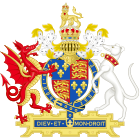Treason Act 1535 facts for kids
| Act of Parliament | |

|
|
| Long title | An Act concerning the Forging of the King's Sign Manual, Signet and Privy Seal. |
|---|---|
| Citation | 27 Hen. 8. c. 2 |
| Other legislation | |
| Repealed by | Treason Act 1553 |
|
Status: Repealed
|
|
The Treason Act 1535 was an important law made in England way back in 1535. It was also known as the Forging the Sign-manual, etc. Act 1535. This law was created during the time of King Henry VIII of England. Its main purpose was to make it a very serious crime to fake royal seals or the king's signature.
Contents
What Was the Treason Act of 1535?
This Act made it a crime called high treason if someone tried to make fake copies of important royal items. High treason was the most serious crime against the king or the country.
What Did the Act Protect?
The Act specifically protected three important royal items:
- The Privy Seal: This was a special stamp used to approve important documents.
- The Signet: This was another royal seal, often used for letters and less formal documents.
- The royal sign-manual: This was the King's own signature.
If anyone tried to counterfeit (make a fake copy of) any of these, they would be charged with high treason.
Why Was This Act Created?
King Henry VIII ruled England from 1509 to 1547. During his reign, he made many big changes. He wanted to make sure his power was strong and respected. Faking royal seals or his signature would have been a direct challenge to his authority. This law helped protect the King's power and the official documents of the government.
What Happened to the Act?
The Treason Act 1535 did not last forever. It was later repealed (cancelled or taken away) by another law called the Treason Act 1553.
However, something interesting happened in the same year, 1553. A new law was passed that brought back the same crime. So, even though the original Act was cancelled, the idea of it came back very quickly.
See Also
- High treason in the United Kingdom

